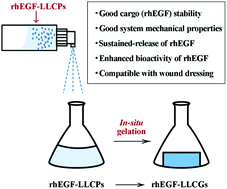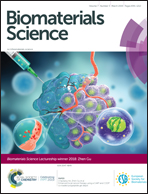In situ gelation of rhEGF-containing liquid crystalline precursor with good cargo stability and system mechanical properties: a novel delivery system for chronic wounds treatment†
Abstract
The objective of this study was to develop a novel delivery system for recombinant human epidermal growth factor (rhEGF) for chronic wound treatment. Such a delivery system should be of good cargo stability and system mechanical properties in order to guarantee a satisfactory wound-healing effect. rhEGF-containing lyotropic liquid crystalline precursors (rhEGF-LLCPs) with in situ gelation capability were considered as a promising candidate to achieve this aim. Various properties of the optimal formulations (rhEGF-LLCP1 and rhEGF-LLCP2) were characterized, including apparent viscosity, gelation time, in vitro release and phase behavior. The stability of rhEGF and system mechanical properties (i.e. mechanical rigidity and bioadhesive force) were verified. Interestingly, rhEGF-LLCP2 with a larger internal water channel diameter exhibited faster release rate in vitro and then better bioactivity in Balb/c 3T3 and HaCaT cell models. Moreover, rhEGF-LLCP2 showed distinct promotion effects on wound closure, inflammatory recovery and re-epithelization process in Sprague-Dawley rat models. In conclusion, rhEGF-LLCP emerged as a prospective candidate to preserve the stability and enhance the wound-healing effect of rhEGF, which might serve as a new delivery system for chronic wound therapies.



 Please wait while we load your content...
Please wait while we load your content...